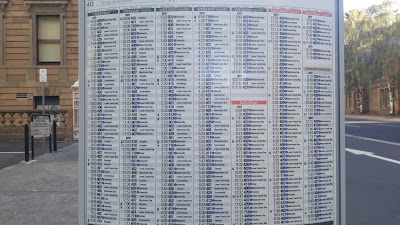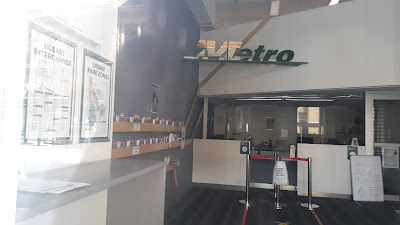There was a long period, about 20 years ago, between the demise of The Met and the commencement of Metlink, when passenger information in Melbourne was terrible, especially for buses. Nothing was maintained, there were seldom timetables at stops and the highly fragmented information available online was a joke.
The Metlink signage project then came along. That improved things with an information flag at each stop. The flag contained information such as the bus route numbers that served the stop and their destinations. Pretty basic stuff but it was previously missing from most stops.
Also revolutionary were stop specific timetables and route maps at almost every stop. These were also previously rare. On the reverse were often local area network maps (although these were later discontinued in the PTV era).
A little later, around 14 or 15 years ago, braille stop IDs were added to sit atop the timetable case. These included a prominent phone number for timetable inquiries (131 638 or 131 MET - the precursor of 1800 800 007) and a stop ID number. IDs could potentially be used for other things like Tram Tracker-style real time information and it's a lost opportunity that they haven't been. Maybe PTV assumes that everyone always has their phone's power-draining GPS positioning always switched on.
To summarise, the Metlink and Viclink projects set a higher base standard for passenger information at almost every bus stop in the state with a flag and timetable at each one. That's pretty much unheard of anywhere else.
Where did it fall short? The information provided set a good minimum standard at residential area stops served by one or two local routes. However basic route-level information doesn't cut it where needs are more complex, like at interchanges where multiple routes depart nearby and passengers are often changing between them.
Can we learn from places where buses are the only public transport and are taken more seriously? Yes we can. Last week I was in Hobart and inspected their CBD interchange information. Below are some pictures and notes from that trip.
Where Hobart does better
Where Hobart does worse
While Hobart's central bus interchange is far better appointed for passenger information than almost anywhere in Melbourne, the minimum standard for stops away from the main interchanges is less. Here are some examples where Hobart is backward.
No unified information style across operators
Melbourne got this to a refined art about ten years ago with its Metlink and Viclink brands and compatible styles for operators like Metro Trains, Yarra Trams and V/Line. Hobart hasn't. Metro basically serves the urban core while fringe and regional areas are served by operators such as Redline and Tassielink. Route numbers are part of the same system but information and fares are only partially so (Tassielink accepts Greencard but Redline doesn't).
Sorry bus stops
I wrote about Melbourne's sorriest bus stops recently here. Hobart also has its fair share. If you are seeking to take regular (ie non-Skybus) public transport from Hobart Airport, you'll be greeted by this after you've done the required 40 minute trek to this stop behind an industrial/retail park.
The bus stop is devoid of information. No route number, no destination, no timetable and not even a web address for information.
A seat is nearby but apart from its obvious decrepitude, it warns of an unexpected hazard.
Poor use of shop window space
Possibly because of a government/bureaucratic legacy, public transport agencies aren't necessarily very good at identifying patronage growth opportunities and marketing their services. Though to be fair it's not just a Hobart thing; South Cross Station is active outside the hours our PTV Hub operates yet it too has not made use of its ample wall space to provide information (eg large CBD maps) for passers by.
Conclusion
There's a lot Melbourne can learn from Hobart in how we present public transport information, particularly at interchanges. We've neglected this a lot in the past as past Metlink work (though good) concentrated on lifting stop information up to a basic minimum standard to the exclusion of making interchanges easier to use. Hence there are many opportunities for improvement in Melbourne as part of public transport's post-COVID patronage rebuild.
























No comments:
Post a Comment